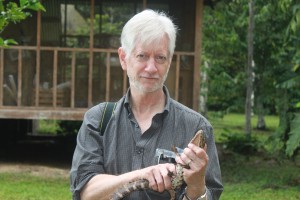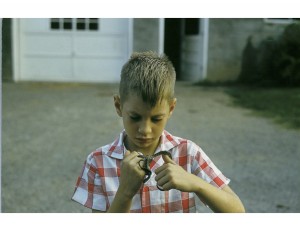
Four-year-old Jack tottered behind his father as he mowed the lawn on a muggy day in rural Tennessee. Out of the corner of his eye he noticed a snake dart out from underneath the lawn mower. Instinctively, he fell on it with both hands. It was the start of a lifelong love affair with reptiles.
A passion for animals is the driving force behind the career of Jack Sites Jr., professor of biology and curator of herpetology at BYU. The 30-year BYU veteran has played a big part in making the College of Life Sciences what it is today. He has thrived at BYU, even as a Roman Catholic.
“When my colleagues ask me how I like BYU, I tell them how great I’ve done here and what a super place it is,” Sites said with his Tennessee twang. ”Even atheists would be happy here. If you can get by the no-coffee rule you can do alright.”
Sites makes sure the biology program has funding, takes trips to South America to study reptiles and has more than 100 published works. He has also helped the Life Sciences department realize the full potential of the Monte L. Bean Science Museum, which boasts a huge research collection and has programs to help both students and the public learn about animals.
“The first thing you need to understand about Jack is that he’s a world-class scientist,” museum director Larry St. Clair said. “He is always looking to move things forward and is never a stumbling block.”
Studying animals, especially reptiles, has always been a hobby for Sites. From a backyard zoo to animal drawings on his school assignments, he was always a little different from the other kids. “I didn’t care about the latest pop music or who was playing in the World Series,” he said. “It was just boring for me.”
When Sites got to college he was a perfect fit for the biology major. He met his wife, Joanne, in a botany class. “At first I didn’t know his hobby was reptiles,” Joanne said. “But Jack was the adventuresome type, and that’s what drew me to him.”

Winning over the in-laws was important for Jack Sites. He remembers hearing how his future mother-in-law would flop down on the front lawn to shoot snakes out of trees. It took some time to convince her not to kill every snake she saw, but he succeeded and became a great son-in-law.
After some time in Tennessee and Texas, Sites took a position as the “vertebrate biologist” at BYU. The Siteses said they had no idea what to expect when they came to Provo.
“I was nervous coming to Utah not knowing anything about the LDS culture,” he said. “I’m a coffee drinker, and learning that I couldn’t have my morning coffee on campus was a real stretch, but I’m OK now.” Despite a lot of questions and a “disgusting” coffee substitute called Postum, he said has made the most of his time at BYU.
Sites is as much at home in the classroom as he is out in the field. He teaches several biology classes and works closely with students. Those with a special passion for reptiles can work alongside him in his herpetology lab. He draws on his adventures in South America to pass on knowledge to students.
Sites remembers how exciting his first trip to Brazil was. Walking through the Amazon with two other scientists, he heard a noise like a bulldozer rooting up trees. The group members realized the source and found themselves surrounded by dangerous wild pigs. The only way out was to climb. “I felt like a cat with no claws trying to climb up a fire pole,” Sites said.
Though one scientist ended up hanging onto a vine, the group made it out safely. “It seemed like forever just clinging onto my tree,” Sites said. “Four or five of those pigs can kill a jaguar. I really didn’t want to let go.”
Although his trips aren’t always that dangerous, Sites continues to take frequent visits to Brazil. This September he will be the keynote speaker at the Brazilian Herpetology Conference.
Sites still has the same passion for animals as the 4-year-old boy who pounced on a snake, something that has made him a great asset to BYU. “Jack will leave a legacy of excellence in whatever he does, whether it’s in the classroom, the laboratory or in an administrative post,” St. Clair said. “His legacy will bless members of the faculty and students for years to come.”




